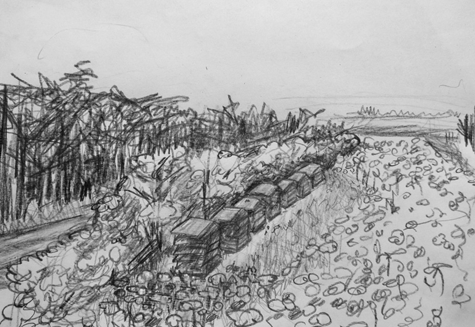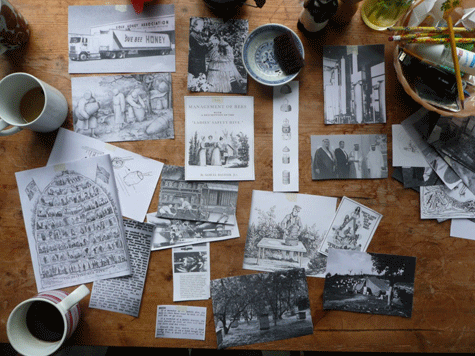IF BEES ARE FEW…
2014, 14 May
IF BEES ARE FEW… THE BOOK!
The second part of my project with Doris Denekamp, If Bees Are Few… is a book.  This publication together with it’s companion piece, the installation in the landscape near Diepenheim, is our contribution to the ‘Non Urban Gardens’. Half of the book is formed by pictures, and archive about bees through the ages – photos, drawings and etchings, showing beekeepers, hives, honeycomb, pollen and much more.
This publication together with it’s companion piece, the installation in the landscape near Diepenheim, is our contribution to the ‘Non Urban Gardens’. Half of the book is formed by pictures, and archive about bees through the ages – photos, drawings and etchings, showing beekeepers, hives, honeycomb, pollen and much more.

.

But nowhere is there a picture of an actual bee – they have already disappeared form the archive. We sent the compiled archive to prize-winning British science, and science-fiction, author, Simon Ings, with the invitation to write a story based on a future… If Bees Are Few… His short story, Jerk Dance, weaves three story lines together to reflect on a changing society in which humans are becoming organised like bee colonies in order to survive in a world where nature has been exhausted. As well as Simon’s story, the book contains an essay by Doris, The Beekeeper’s Veil – how our gaze became shrouded, on the changing relationship between man and bees, and a reflective bee text, Augury, by me.

The cover of the book is made from special paper saturated with seeds… plant it to grow flowers for bees! The wonderful Swiss graphic designer Anna Haas collaborated with us for the deign of this book.
Doris has made a great VIDEO of the book, see it here.
…
IF BEES ARE FEW… THE OUTDOOR INSTALLATION!
As part of the NON-URBAN GARDENS project, this sculptural work in collaboration with Doris Denekamp, If Bees Are Few…, opened as part of the Non Urban Gardens project in Diepenheim this week.

.
Unfortunately it rained like crazy so the bees sensibly stayed in their hives!

.

…
Diepenheim is a rural village, in an environment nowadays dominated by large areas of maize, grown as cattle feed. This agriculturalisation of the landscape has formed the backdrop for our Non-Urban Garden.
In recent years, an alarming increase in the death of bee populations has been observed worldwide. In Europe, the Netherlands has the highest recorded percentage of bee deaths. The reason behind the deaths has, for a long time, been unclear, but now more and more independent researchers point at a connection with a relatively new insecticide: imidacloprid. This systemic insecticide, though not intentionally aimed at honey bees, is nonetheless absorbed by them. It affects the bee’s nervous system and causes a severe weakening of bee populations, which makes them vulnerable to moulds, mites and viruses. Despite partial banning in several European countries, the Dutch government, kowtowing to an aggressive lobby by pesticide manufacturers, has not taken any steps to prohibit these dangerous insecticides.
For our Non-Urban Garden we therefore planned a garden specifically for bees. The original plan which Doris Denekamp and I presented at Kunstvereniging Diepenheim in March 2014, along with a small booklet of the design, involved a garden filled with plants that that can provide food for the bees or that have other properties beneficial to them. The layout of the garden would follow the molecular structure of the insecticide imidacloprid, and refer to the tradition of geometrical floral clocks. Six beehives, cared for by a local bee keeper, would be painted with the portraits of people who ‘have bees in their heads’, people committed to the honey bee’s well being – Emily Dickinson (poet and gardener), Rachel Carson (writer and eco-activist), Henk Tennekes (toxicologist specialised in bee deaths), Jan Rabe (local bee keeper), St Ambrose (patron saint of bees and bee keepers) and Bhramari Devi (Indian bee goddess). With time, the geometric shape of the ‘enemy molecule’ would gradually become diffused and ‘conquered’ – a symbolic victory for nature. Unfortunately that plan encountered a number of logistical factors, in particular the difficulty of finding a large location for the fantasy plan we had initially envisaged, as well as the problem of upkeep, prompted us to develop a new plan for this garden relating to the issue of worldwide bee deaths…
.
Our new and definitive work for If Bees Are Few… consists of two complimentary parts – a book and a sculptural work in the landscape. 
The first part of If Bees Are Few… consists of a sculptural work in the landscape – a row of beehives, two of which are inhabited by bees and buzz with life, the others, their companions, are silent, fossilised. These other (five) hives have been cast in concrete and form a kind of burial monument for the honeybee. The row of hives is situated on a ‘terp’, a raised mound of earth, and surrounded by a meadow of flowering plants which are useful to bees, either for their nectar or their pollen, or for bee well-being. 
.
Here are some photos of the concrete beehives being made:

.

.

.

.
And of their installation, along with the information tables, by Doris and her team of helpers, on location in Diepenheim. (Unfortunately I had injured my foot so I couldn’t be there):

.

.

.

.
The live beehives were delivered larer, once the weather warmed up sufficiently (it’s an unfortunately windy location until the trees mature).
…
The second part of If Bees Are Few… is an artists’ book. This publication, together with the hives, is the ‘Non-Urban Garden’. In collaboration with Swiss designer Anna Haas (alumna Werkplaats Typografie) we developed a book that propagates the story of the bee. The project’s title forms the premise for the book – what if bees die out, what is lost if bees are no more? Not only in the practical sense – the pollination of plants, the consequences for food and the economy – but also in the imaginative or symbolic sense – bees having had such a prominent place in mythology and legend, etc. As the book should encompass not only the past and the present in terms of bees, but also the future, we decided to ask the British author Simon Ings to write a fictitious story relating to the idea – If bees are few…

Doris Denekamp and I went on the road, visiting the Bee Museum (Bijenteeltmuseum) in Lanaken, Belgium, where we took photographs of the plethora of wonderful bee-related objects stored there. Here Doris is photographing a basket-work St. Ambrose, patron saint of beekeepers.

We then selected 250 photographs of bee-related images and printed them as photographs to send to Simon Ings, the prize-winning, British science and science-fiction author who will use them as inspiration to write a short story for our book as part of the If Bees Are Few… project… a kind of ‘time-capsule’ that could have been launched in order to explain bees to some future generation at a time when bees no longer exist, as the basis for a story from the perspective of a future (or even from the perspective of the almost extinct bee in the future…) when this scenario has become reality.

We sent them off in this antique archive drawer. None of the pictures show actual bees… they have already disappeared from the archive…
The contents of the capsule functioned as a collage through which, in an associative fashion, the history of the bee from mythical creature to its marginalisation in current society. This archive of images, artefacts and articles will form the background for the story. In addition to this, the cover of the book is made from special paper impregnated with the seeds of plants propitious to bees, in this way the book If Bees Are Few… itself, when planted, really does become the Non-Urban Garden.
.
The Book, If Bees Are Few……  This publication together with it’s companion piece, the installation in the landscape near Diepenheim, is our contribution to the ‘Non Urban Gardens’. Half of the book is formed by pictures, and archive about bees through the ages – photos, drawings and etchings, showing beekeepers, hives, honeycomb, pollen and much more.
This publication together with it’s companion piece, the installation in the landscape near Diepenheim, is our contribution to the ‘Non Urban Gardens’. Half of the book is formed by pictures, and archive about bees through the ages – photos, drawings and etchings, showing beekeepers, hives, honeycomb, pollen and much more.

.

But nowhere is there a picture of an actual bee – they have already disappeared form the archive. We sent the compiled archive to prize-winning British science, and science-fiction, author, Simon Ings, with the invitation to write a story based on a future… If Bees Are Few… His short story, Jerk Dance, weaves three story lines together to reflect on a changing society in which humans are becoming organised like bee colonies in order to survive in a world where nature has been exhausted. As well as Simon’s story, the book contains an essay by Doris, The Beekeeper’s Veil – how our gaze became shrouded, on the changing relationship between man and bees, and a reflective bee text, Augury, by me.

The cover of the book is made from special paper saturated with seeds… plant it to grow flowers for bees! The wonderful Swiss graphic designer Anna Haas collaborated with us for the deign of this book.
Doris has made a great VIDEO of the book, see it here.
.
…
.
(Kunstvereniging Diepenheim have also published a book chronicling all the Non-Urban Garden projects in which Doris Denekmap and I are included: The Non Urban Garden – Gardens of the 21st Century.
Gardens of the 21st Century.

The book includes work by the artists as well as a number of experts (Peter Sonderen, Joop Hoogeveen, Ann Meskens, Erik A. de Jong, Sakia de Wit, Piet Oudolf en Jorrit Noordhuizen) who explain their vision on the topic.)
…
